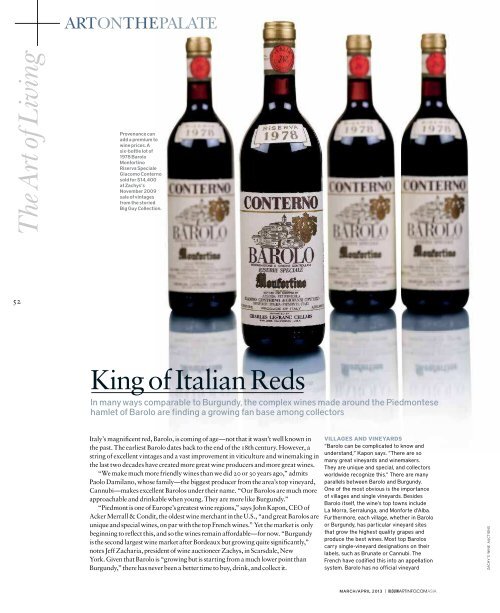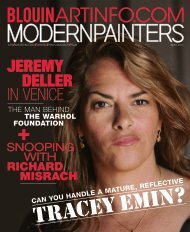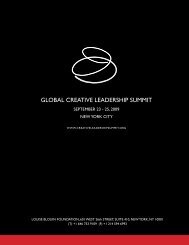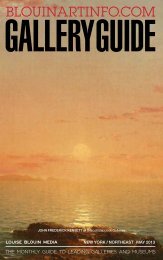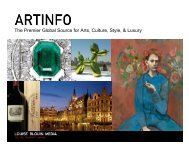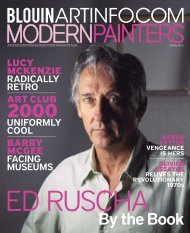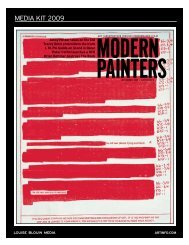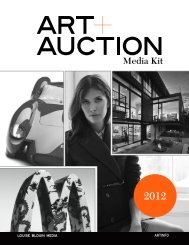Linke - Artinfo
Linke - Artinfo
Linke - Artinfo
You also want an ePaper? Increase the reach of your titles
YUMPU automatically turns print PDFs into web optimized ePapers that Google loves.
The Art of Living<br />
52<br />
arTonThepalaTe<br />
Provenance can<br />
add a premium to<br />
wine prices. A<br />
six-bottle lot of<br />
1978 Barolo<br />
Monfortino<br />
Riserva Speciale<br />
Giacomo Conterno<br />
sold for $14,400<br />
at Zachys’s<br />
November 2009<br />
sale of vintages<br />
from the storied<br />
Big Guy Collection.<br />
King of Italian Reds<br />
In many ways comparable to Burgundy, the complex wines made around the Piedmontese<br />
hamlet of Barolo are finding a growing fan base among collectors<br />
Italy’s magnificent red, Barolo, is coming of age—not that it wasn’t well known in<br />
the past. The earliest Barolo dates back to the end of the 18th century. However, a<br />
string of excellent vintages and a vast improvement in viticulture and winemaking in<br />
the last two decades have created more great wine producers and more great wines.<br />
“We make much more friendly wines than we did 20 or 30 years ago,” admits<br />
Paolo Damilano, whose family—the biggest producer from the area’s top vineyard,<br />
Cannubi—makes excellent Barolos under their name. “Our Barolos are much more<br />
approachable and drinkable when young. They are more like Burgundy.”<br />
“Piedmont is one of Europe’s greatest wine regions,” says John Kapon, CEO of<br />
Acker Merrall & Condit, the oldest wine merchant in the U.S., “and great Barolos are<br />
unique and special wines, on par with the top French wines.” Yet the market is only<br />
beginning to reflect this, and so the wines remain affordable—for now. “Burgundy<br />
is the second largest wine market after Bordeaux but growing quite significantly,”<br />
notes Jeff Zacharia, president of wine auctioneer Zachys, in Scarsdale, New<br />
York. Given that Barolo is “growing but is starting from a much lower point than<br />
Burgundy,” there has never been a better time to buy, drink, and collect it.<br />
VILLAGES AND VINEYARDS<br />
“Barolo can be complicated to know and<br />
understand,” Kapon says. “There are so<br />
many great vineyards and winemakers.<br />
They are unique and special, and collectors<br />
worldwide recognize this.” There are many<br />
parallels between Barolo and Burgundy.<br />
One of the most obvious is the importance<br />
of villages and single vineyards. Besides<br />
Barolo itself, the wine’s top towns include<br />
La Morra, Serralunga, and Monforte d’Alba.<br />
Furthermore, each village, whether in Barolo<br />
or Burgundy, has particular vineyard sites<br />
that grow the highest quality grapes and<br />
produce the best wines. Most top Barolos<br />
AUCTIONS<br />
carry single-vineyard designations on their<br />
labels, such as Brunate or Cannubi. The<br />
WINE<br />
French have codified this into an appellation<br />
system. Barolo has no official vineyard ZACHY’S<br />
MARCH/APRIL 2013 | BLOUIN<strong>Artinfo</strong>.comAsiA<br />
CLOCKWISE FROM LEFT: ACKER MERRALL & CONDIT; BARTOLO MASCARELLO; GAJA; BRUNO GIACOSA<br />
ranking, but such vineyards as Brunate near<br />
La Morra and Cannubi in Barolo have long<br />
been considered the region’s finest. “There<br />
are many excellent small vineyards for Barolo<br />
but the very best are well known,” says<br />
Bruno Ceretto, whose family is a top producer<br />
of Barolo and other wines of the region.<br />
“We are lucky enough to own parts of many<br />
of them including Cannubi and Rocche.”<br />
TOP WINERIES<br />
A number of wineries and growers may<br />
share ownership of a vineyard. The vineyard<br />
of Cannubi, for instance, has almost twodozen<br />
individual grape growers and almost<br />
as many different wine producers using the<br />
name. Granted, nothing is as complicated<br />
as Burgundy, with such appellations as Clos<br />
Vougeot, which includes almost 70 different<br />
owners, but Barolo has similar complexity<br />
that takes some time to understand. For<br />
those new to collecting, it is easier to focus<br />
on the best producers with long reputations<br />
for making top wines. Some excellent<br />
wineries to consider that are readily available<br />
are Ceretto, Pio Cesare, Aldo Conterno,<br />
Giacomo Conterno, Bruno Giacosa, Luciano<br />
Sandrone, Paolo Scavino, and Roberto<br />
Voerzio. Angelo Gaja is also a great producer<br />
of reds from the Barolo area, but the winery<br />
labels its best wines under the appellation<br />
Langhe Doc. His two top wines from the<br />
area are Conteisa and Sperss.<br />
VINTAGES TO WATCH FOR<br />
Choosing the best vintages in Barolo is less<br />
difficult. Every year after 1995 is outstanding.<br />
In fact, Barolo hasn’t had a poor vintage<br />
overall since 2002. “Barolo has had so many<br />
excellent vintages in the last 15 years that<br />
it’s almost a problem,” admits Matteo Einaudi<br />
of Luigi Einaudi, whose Cannubi Barolo<br />
BLOUIN<strong>Artinfo</strong>.comAsiA | MARCH/APRIL 2013<br />
is top-tier. I am a fan of warmer, sunnier<br />
vintages that produce rounder textured and<br />
richer Barolos. These years include 1997,<br />
2000, and 2007. I also like sunny, fresh, and<br />
late grape-growing seasons that make more<br />
balanced wines. These vintages include 1996,<br />
1998, and 2008. Colder years produce more<br />
tannic wines, as in 1999 and 2006, which<br />
need more bottle age to soften and become<br />
drinkable. Older vintages to keep an eye out<br />
for are: 1978, 1982, 1985, 1989, and 1990.<br />
These show how Barolo ages wonderfully and<br />
approaches great Burgundy as it matures.<br />
A GROWING AUDIENCE<br />
“Italy has done a great job marketing<br />
itself as a brand throughout Asia for style,<br />
fashion, wine, and food,” Kapon says.<br />
“Italian wines, and Barolo specifically, are<br />
among the beneficiaries. Our collectors<br />
in Hong Kong want to add the top Barolo<br />
producers to their collections, older and<br />
more recent vintages alike.” Both Kapon<br />
and Zacharia, however, note that the<br />
U.S. market has been growing consistently<br />
for more than five years and that South<br />
American collectors have also been laying<br />
in Barolos recently. “Demand for Barolo is<br />
becoming increasingly global,” says Kapon.<br />
THE ALLURE OF PROVENANCE<br />
The top names for collectors and<br />
investors in Barolos (not including Gaja<br />
because technically it doesn’t make one)<br />
are: Aldo Conterno, Giacomo Conterno,<br />
Bruno Giacosa, Bartolo Mascarello, and<br />
Roberto Voerzio. When buying at auction,<br />
provenance—as well as winery and vintage—<br />
can be a factor. “Owing to Barolo’s not being<br />
widely collected in the U.S. before the late<br />
1990s,” Zacharia says, “Barolo rarities tend<br />
to appear as part of truly great cellars that<br />
were amassed over decades, rather than<br />
a case here, a case there showing up at<br />
auction.” Bottles from such collections are<br />
likely to fetch higher prices than ones with<br />
lesser-known backgrounds. For example, the<br />
highest price Zachys has ever realized for a<br />
single bottle of Barolo Monfortino Riserva<br />
Speciale Giacomo Conterno 1961 was $1,680<br />
in November 2009. It was auctioned as part<br />
of the Big Guy Collection, an extraordinarily<br />
strong group that spanned several auctions.<br />
Since that time, bottles of the same wine<br />
have earned from as low as around $650 to<br />
as high as $1,220, but have never achieved<br />
quite the same price. — JAMES SUCKLING<br />
All in the Details<br />
+ The Accademia del Barolo, comprising<br />
14 producers who work together to promote<br />
Barolo appreciation worldwide, holds<br />
events and auctions at least twice yearly, in<br />
Europe, Asia, and North America.<br />
+ Be careful when purchasing older vintages.<br />
Many ancient bottles of Barolo have not<br />
been stored properly, particularly those<br />
under the Gaja and Giacomo Conterno<br />
From left:<br />
An enormous<br />
bottle of a great<br />
Barolo, the 1952<br />
Giacomo Conterno<br />
Monfortino,<br />
fetched $24,200<br />
in April 2008, the<br />
highest price paid<br />
for a bottle of<br />
Barolo at an Acker<br />
Merrall & Condit<br />
auction. That price<br />
was an anomaly<br />
because it was<br />
such an unusually<br />
large bottle—13.5<br />
liters, more than<br />
an entire case<br />
of wine in a single<br />
bottle—a size<br />
rarely made these<br />
days. Among<br />
the best regarded<br />
winemakers and<br />
most sought after<br />
estates of the<br />
region are Bruno<br />
Giacosa, Angelo<br />
Gaja, and Bartolo<br />
Mascarello.<br />
labels. Nonetheless, I have recently<br />
drunk amazing old bottles of Giacomo<br />
Conterno Monfortino Riserva from the<br />
1960s and 1950s.<br />
+ Older vintages, whose age brings out<br />
similarities to Burgundy, include 1978, 1982,<br />
1985, 1989, and 1990.<br />
+ For more information go to jamessuckling.com<br />
53


